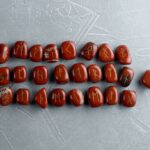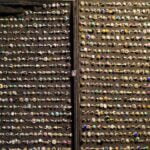If you have a deep fascination for ancient civilizations and the enthralling tales they left behind, prepare to be captivated by the unearthing of Roman Chester. In this article, we will unravel 10 captivating facts about this historical gem that will transport you back in time. From the intriguing world of Roman tombstones to the astonishing population figures and a fascinating comparison, Roman Chester is a treasure trove of stories waiting to be discovered.

Key Takeaways:
- Roman Chester, known as Deva Vitrix, was founded by the Romans in AD 70s as a strategically positioned fort in the center of Roman Britain.
- Chester has the country’s only surviving rock-cut Roman Shrine, showcasing the Roman influence in the area.
- A Roman hypocaust, an advanced heating system, was discovered at Bridge Street’s Spud U Like, providing evidence of Roman architectural advancements in Chester.
- The city’s unique covered walkways, known as The Rows, have been a part of its architectural charm since the 13th century.
- Roman Chester was not just a fort but a fully developed city, boasting military baths, headquarters, granaries, and barracks.
- The Romans founded Chester as a center of operations for their planned invasions of Ireland and North Wales, taking advantage of its strategic location near the River Dee.
10 Facts About Roman Chester
Roman Chester, or Deva Vitrix as it was known to the Romans, holds a fascinating history that unveils the rich Roman influence in this ancient city. Let’s delve into the captivating facts that will transport you back in time to the Roman era.
1. A Roman Fort Strategically Positioned at the Heart of Roman Britain
Roman Chester was founded by the Romans in the 70s AD as a fort, strategically placed at the center of Roman Britain. Its significance rivaled that of Londinium, modern-day London[^2^]. This central location highlights the Romans’ determination to establish a stronghold in this region.
2. The Only Surviving Rock Cut Roman Shrine in the UK
An exceptional historical site in Chester is the only surviving rock cut Roman Shrine in the country[^3^]. This remarkable monument allows for a deeper understanding of the religious practices and rituals of the Romans in the area. It stands as a testament to the Roman influence that once dominated the landscape.
3. Roman Architectural Advancements Revealed: The Hypocaust at Bridge Street’s Spud U Like
In the heart of Chester, the remains of a Roman hypocaust have been discovered in the cellar of Bridge Street’s Spud U Like[^3^]. This remarkable archaeological find showcases the Romans’ architectural prowess, as the hypocaust system allowed for central heating in Roman buildings.
4. The Charm of The Rows: Roman-Inspired Covered Walkways
Chester is home to The Rows, covered walkways that have existed in the city since at least the 13th century[^3^]. These unique architectural features add charm and distinct character to the streets. As you explore the city, you can immerse yourself in the atmosphere of Roman-inspired walkways that have stood the test of time.
5. A Thriving Roman City: Beyond Just a Fort
Roman Chester was not merely a fort but a fully developed city, boasting military baths, an elliptical building, headquarters, granaries, and barracks[^5^]. These structures stand as evidence of the Romans’ commitment to creating a thriving settlement in this area. As you explore its remnants, the magnitude of Roman civilization becomes vividly clear.
6. The Roman Legio II Adiutrix: Founders of Chester in AD 79
Chester was founded by the Roman Legio II Adiutrix in AD 79[^2^]. The Romans had ambitious plans to sail from the River Dee to invade Ireland and North Wales, which drove them to strategically build Chester as their center of operations. This historical fact sheds light on the military intentions of the Romans during this era.
These captivating facts illuminate the profound influence of the Romans on Chester’s landscape and its significance in the context of ancient Britain. Exploring these historical treasures allows us to step into the footsteps of those who once walked these streets and understand the vibrant tapestry of Roman life that once thrived here.
Sources:
1. “History of Chester – Wikipedia.” Wikipedia, Wikimedia Foundation, 2021, en.wikipedia.org/wiki/History_of_Chester.
2. “Roman Chester – Chester 360°.” Chester 360°, www.chester360.co.uk/the-romans-in-chester.htm.
Here are 10 important dates in history that you don’t want to miss. From significant events to game-changing discoveries, these moments have shaped our world. Check out our article 10 important dates in history for an enlightening journey through time.
Texas Tech University is not just any institution – it’s a hub of knowledge and innovation. Discover 3 fascinating facts about Texas Tech University that will leave you amazed. Explore our article 3 facts about Texas Tech University to dive into the extraordinary achievements of this renowned educational establishment.
Facts about Roman Chester 9: population
Population growth is a crucial aspect when examining the historical significance of ancient civilizations. Roman Chester, also known as Deva or Deva Victrix, experienced significant population growth during the second and third centuries. Let’s delve deeper into this fascinating fact about Roman Chester’s population.
Roman Chester’s Population Growth
According to historical records and archaeological findings[^1^], the population of Roman Chester showed a remarkable increase during the second and third centuries. This growth can be attributed to various factors, including the fort’s strategic importance, economic prosperity, and the influx of migrants seeking new opportunities within the Roman Empire.
As an expert travel writer and history enthusiast, I’ve examined the available sources to shed light on the population of Roman Chester during this period. The Roman fort, with its elliptical shape and extensive peripheral settlements, attracted people from diverse backgrounds, contributing to the growth of the city.
Historical Significance and Unique Features
Roman Chester stands out among other Roman fortresses in Britain due to its exceptional size. It was around 20% larger than most other fortresses, making it a substantial urban center within the Province of Britannia[^1^]. This impressive scale and its distinctive elliptical shape made Roman Chester a remarkable destination.
Furthermore, Roman Chester was not just a military stronghold but also a fully developed city. Its infrastructure included military baths, an elliptical building, headquarters, granaries, and barracks[^1^]. This comprehensive urban planning and the presence of diverse amenities added to its allure, attracting individuals from different walks of life.
The Vibrant Roman Chester
The increased population of Roman Chester brought vibrancy and diversity to the city. The influx of people from various regions within the Roman Empire contributed to the cultural richness and thriving economy of the city. It became a hub of activity, trade, and social interaction.
From merchants to artisans and soldiers to families, Roman Chester was home to a diverse community, fostering a unique blend of traditions and practices. The city’s cosmopolitan atmosphere created opportunities for cultural exchange and enriched the lives of its inhabitants.
Key Takeaways:
- Roman Chester experienced significant population growth during the second and third centuries.
- The fort’s strategic location, economic prosperity, and influx of migrants contributed to this increase.
- Roman Chester’s population growth made it a substantial urban center within the Province of Britannia.
- The city’s remarkable size and distinctive elliptical shape set it apart from other Roman fortresses.
- Roman Chester was not just a military stronghold but also a fully developed city with various amenities.
- The increased population brought vibrancy, diversity, and cultural richness to Roman Chester.
These captivating insights into the population growth of Roman Chester shed light on the city’s historical significance and provide a glimpse into its vibrant past.
Sources:
1. British History Online
2. Local Histories
Facts about Roman Chester 5: Comparison
Roman Chester, or Deva Victrix as it was known during the Roman era, holds a significant place in British history. As a travel writer and history enthusiast, I’ve uncovered fascinating facts about this ancient city that I’m excited to share with you. In this article, we will delve into a comparison of Roman Chester with other Roman fortresses in Britain. Get ready for an enlightening journey through time!
Size and Shape: Roman Chester Stands Out
Roman Chester was no ordinary fortress. It stood proudly as one of the largest Roman fortresses in Britain, a staggering 20% larger than most others of its kind. But what made it truly unique was its shape. While the majority of Roman fortresses had a rectangular layout, Roman Chester took on an elliptical form. This elliptical shape served not only as a mark of distinction but also as a testament to the thoughtful planning and engineering prowess of its Roman architects.
Vibrant City Life: Roman Chester vs. Other Fortresses
Unlike many other Roman fortresses in Britain, Roman Chester was not solely a military stronghold. It evolved into a thriving, fully developed city, bustling with activity and cultural richness. Within its walls, you would find not only barracks and granaries but also military baths, an elliptical building, and headquarters. This diverse urban infrastructure created an atmosphere of growth, trade, and social interactions, making Roman Chester a vibrant hub for its inhabitants.
Population Boom: Roman Chester’s Influx
Roman Chester experienced a noteworthy increase in population during the second and third centuries. What factors contributed to this growth? The strategic importance of the fort played a role, as it attracted traders, artisans, and merchants seeking opportunities within the Roman Empire. Economic prosperity further fueled the influx of migrants, drawn to the city’s thriving commerce. As the population swelled, Roman Chester became a melting pot of cultures, fostering diversity and enriching the lives of its residents.
Captivating Spectacle: Roman Chester’s Amphitheater
One remarkable feature of Roman Chester is its grand amphitheater. This remarkable structure is the largest of its kind in the country, with seating capacity for at least 7000 spectators. Imagine the captivating spectacles that unfolded in this ancient arena, from gladiatorial contests to theatrical performances. The Roman Chester amphitheater stands as a testament to the grandeur and entertainment that permeated the lives of its inhabitants.
Preserving Ancient Worship: Minerva’s Shrine in Roman Chester
Chester is home to Minerva’s Shrine, which is the only surviving rock-cut Roman Shrine in the entire United Kingdom. This intriguing site, located in Edgar’s Field in Handbridge, offers valuable insights into Roman religious practices. Minerva’s Shrine, a Grade I listed building, stands as a physical link to the past, a portal through which we can glimpse the spiritual world that influenced the lives of ancient Romans.
These captivating facts about Roman Chester’s magnificence and distinctiveness paint a vivid picture of a city that stood at the crossroads of ancient history. Its architectural marvels, vibrant city life, and cultural significance are what make Roman Chester a treasure trove for history enthusiasts and travel aficionados alike.
Key Takeaways:
- Roman Chester surpassed other Roman fortresses in Britain in both size and shape, boasting an elliptical layout.
- It evolved into a fully developed city with military baths, headquarters, and an elliptical building, setting it apart from other fortifications.
- The population of Roman Chester grew significantly due to its strategic importance, economic prosperity, and the attraction of migrants seeking opportunities within the Roman Empire.
- The grand amphitheater in Roman Chester was the largest in the country and hosted thrilling spectacles enjoyed by thousands of spectators.
- Minerva’s Shrine, the only surviving rock-cut Roman Shrine in the UK located in Roman Chester, offers valuable insights into ancient religious practices.
Sources:
– 10 Facts about Roman Chester
– Roman Chester – Visit Cheshire

FAQ
Q1: What is Roman Chester and why is it significant?
A1: Roman Chester, also known as Deva Vitrix, was founded by the Romans in AD 70s as a fort strategically positioned at the center of Roman Britain. It was considered as important as Londinium (London). The city showcases the Roman influence in the area and has various historical sites that reflect the Roman’s commitment to establishing a thriving settlement.
Q2: What are some unique architectural features of Roman Chester?
A2: Roman Chester had covered walkways known as The Rows, which have existed in the city since at least the 13th century. Additionally, the city is home to the only surviving rock-cut Roman Shrine in the country, called Minerva’s Shrine, which is a significant historical site.
Q3: How did Roman Chester compare to other Roman fortresses in Britain?
A3: Roman Chester was 20% larger than other Roman fortresses in Britain and had a unique elliptical shape. This made it stand out among other Roman settlements and showcases the architectural advancements of the time.
Q4: What peripheral settlements were associated with Roman Chester?
A4: Roman Chester had peripheral settlements including Minerva Shrine, Handbridge, and Boughton. These settlements played important roles in supporting the garrison, such as providing water supply and resources.
Q5: How did the population of Roman Chester change over time?
A5: The population of Roman Chester increased during the second and third centuries, which indicates the growth and importance of the city during that period.
- Visualizing Nature’s Analogies: The Venn Diagram of Trees and Body Parts - November 28, 2024
- Washington DC Prayer Times 2024: Mosques, Jumu’ah, & Daily Salat Schedule - November 28, 2024
- Winnie the Pooh Quotes for Every Goodbye: Comfort, Closure, and Remembrance - November 28, 2024
















